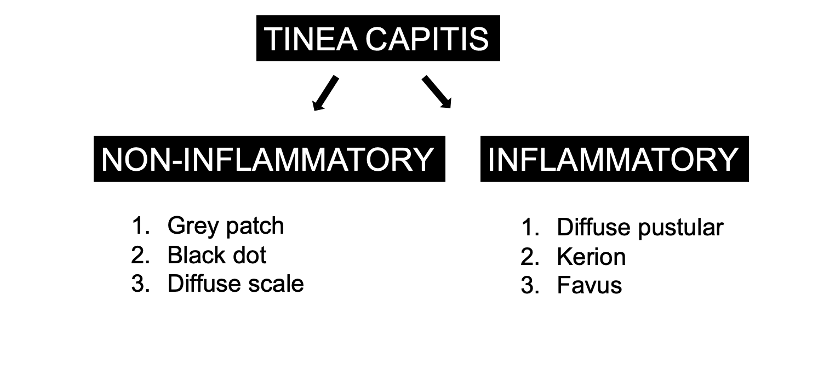Permanent Scarring in 25 % Patients with Kerion
Up to One Quarter of Patients with Kerion May have Permanent Scarring Hair Loss
Tinea capitis refers to a type of fungal infection of the scalp. Children are more commonly affected than adolescents and adults. The condition is due to infection with either a dermatophyte of the Trichophyton genera (like Trichophyton tonsurans for example) or Microsporum (like Microsporum canis for example). A wide variety of clinical presentations are seen with tinea capitis including non inflammatory and inflammatory forms. These are shown in the figure below.
Kerion: How often does it lead to permanent scarring alopecia?
Kerion is a highly inflammatory form of tinea capitis. Patients present with inflamed, red, painful boggy scalps. An important worry that we have when we see patients with kerion is that they may have permanent hair loss is aggressive treatment is not instituted.
Friedland et al. 2022
Friedland and colleagues set out to assess clinical and epidemiologic features of children with kerion celsi and risk factors for scarring. They performed a retrospective review medical records of pediatric patients with kerion treated between January 2006 and July 2020. Overall, out of 389 patients diagnosed with tinea capitis, 80 (20.5%) patients had clinical findings compatible with kerion. The median age at diagnosis of kerion was 6.6 years (range 0.3– 17.8). The prevalence of permanent alopecia was 27.5%.
Bacterial cultures were taken for 29 patients. Of the 12 (41.4%) positive cultures, 9 grew Staphylococcus aureus and 3 grew Acinetobacter spp. Antibiotic treatment was prescribed for 35 patients (44%). Outcomes did not differ by pathogen, antifungal treatment prescribed, duration of treatment, or the use of prednisone or antibiotics.
Conclusion
An important finding of this study was that scarring may occur in one quarter of those with kerion. It’s also interesting that the use of prednisone and the type of pathogen did not affect outcome in this small study.
Early and aggressive treatment of kerion is needed to prevent scarring alopecia and permanent hair loss.
REFERENCE
Friedland et al. Epidemiologic features and risk of scarring in pediatric patients with kerion celsi. Pediatr Dermatol. 2022 Jan 13. doi: 10.1111/pde.14916. Online ahead of print.
This article was written by Dr. Jeff Donovan, a Canadian and US board certified dermatologist specializing exclusively in hair loss.

